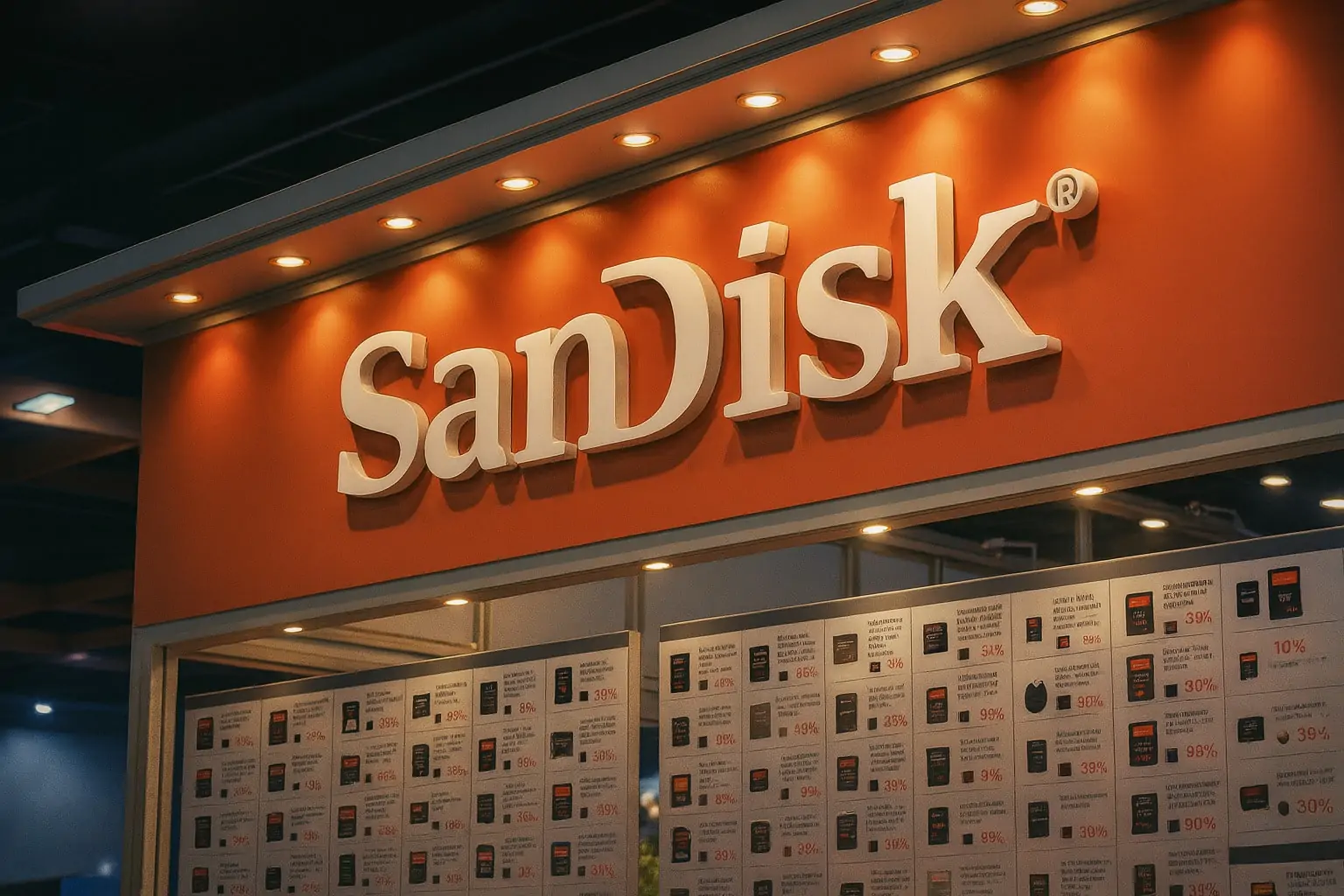SanDisk Corporation (SNDK) stock is reeling after a 20% one‑day plunge, even as Bank of America lifts its price target to $300 and shareholders back the board and executive pay. Here’s everything investors need to know about SanDisk today, 21 November 2025.
- Share price: Around $196 per share, with SanDisk down roughly 20% over the past 24 hours, making it one of the biggest losers in the U.S. market. [1]
- Violent sell‑off: A broad tech and AI‑chip rout, renewed U.S.–China trade worries and profit‑taking after a ~585% year‑to‑date rally triggered the steep drop. [2]
- Bank of America still bullish: BofA has raised its SNDK price target to $300 from $270 and reiterated a Buy rating after an investor meeting with SanDisk’s CEO and CFO. [3]
- Shareholders back management: At the latest annual meeting, investors re‑elected seven directors, approved executive compensation and re‑appointed KPMG as auditor. [4]
- Fundamentals remain strong: Fiscal Q1 2026 revenue climbed 23% year‑on‑year to $2.31 billion, with non‑GAAP EPS of $1.22 and guidance for Q2 2026 EPS of $3.00–$3.40. [5]
- Wall Street sees upside: Zacks estimates that the average analyst price target implies ~34% upside from current levels, underscoring how far the stock has fallen relative to expectations. [6]
SNDK stock price today: SanDisk reels from its biggest one‑day drop of 2025
SanDisk Corporation (SNDK), the flash memory and NAND storage specialist recently spun out of Western Digital, is back in focus for all the wrong reasons.
As of Friday, 21 November 2025, SNDK is trading around $195–$196 per share, roughly 20% lower than 24 hours ago, according to TradingView, Google Finance and exchange data. [7]
On Thursday, 20 November, the stock:
- Plunged 20.33% to about $195.96,
- Traded between an intraday high of $254.60 and low of $192.62,
- And sat within a 52‑week range of $27.90 to $284.76. [8]
That kind of move effectively wiped out tens of billions of dollars in market value in a single session. AInvest notes that SanDisk’s market cap had surged to roughly $40 billion earlier in 2025 before the latest sell‑off; at roughly $196 per share and 146.6 million shares outstanding, it is now closer to the high‑$20 billion range. [9]
Simply Wall St’s morning market note for 21 November lists SanDisk as one of the top losers in the U.S. market, highlighting its 20.33% drop alongside other hard‑hit names. [10]
What triggered SanDisk’s 20% plunge?
While Thursday’s move initially puzzled some market dashboards (“no news reported” was the early verdict on a few screeners), more detailed reporting over the past 24 hours points to a perfect storm of macro and sector‑specific pressures interwoven with SanDisk’s own stunning run‑up.
1. AI chip and memory sector rout
AInvest and other market commentators describe the sell‑off as part of a broader AI‑chip and memory stock shakeout:
- Concerns over U.S.–China trade tensions resurfaced after data showed a 6.5% drop in U.S.–China trade volumes in August, reinforcing fears about export controls and demand from Chinese hyperscalers. [11]
- In Asia, semiconductor and chip‑related names, including SK Hynix and others, also sold off sharply. [12]
- Nvidia, a key bellwether for AI infrastructure demand, swung from a strong post‑earnings pop to losses, contributing to a broader NASDAQ and S&P 500 pullback of more than 1.5%. [13]
With SanDisk increasingly viewed as an AI infrastructure winner thanks to its high‑performance NAND and data‑center SSD portfolio, the name has become tightly linked to sentiment across the AI and semiconductor complex.
2. Trade and regulatory risk
The AInvest analysis also points to regulatory crackdowns on AI chip exports to China and ongoing investigations into smuggling of high‑end GPUs as a key overhang. [14]
While these developments don’t directly target SanDisk’s products, they:
- Increase uncertainty over data‑center capex patterns,
- Raise questions about long‑term demand visibility for AI‑related storage,
- And may spark investors to derisk across the entire memory stack—including NAND suppliers like SanDisk.
3. A huge run‑up meets gravity
Perhaps the most important backdrop: SanDisk has been one of 2025’s most explosive performers.
AInvest estimates that SNDK shares had surged nearly 585% this year before this week’s correction, helped by a supply‑driven rebound in NAND prices and aggressive capacity discipline across the industry. [15]
MarketBeat’s earlier coverage notes that:
- The stock recently traded as high as $265.88,
- Sports a triple‑digit price‑to‑earnings multiple (around the mid‑700s on trailing earnings),
- And has seen heavy interest from hedge funds and institutional buyers. [16]
When a stock has run that far, that fast, any wobble in macro or sector sentiment can trigger:
- Programmatic selling (risk models and momentum strategies flipping from buy to sell),
- Profit‑taking by early institutional winners,
- And a cascade of stop‑loss orders from retail and options‑driven traders.
That appears to be exactly what happened to SanDisk on Thursday.
Bank of America lifts SanDisk price target to $300 and stays bullish
Despite the brutal price action, Bank of America Securities is not backing away.
Fresh $300 price target
On 20 November, BofA:
- Raised its SNDK price target to $300 from $270,
- Reiterated a Buy rating,
- And described SanDisk as a key beneficiary of AI‑driven storage demand and improving NAND pricing. [17]
GuruFocus and other coverage of the meeting emphasize that BofA’s more optimistic stance followed an investor session with CEO David Goeckeler and CFO Luis Visoso, where management outlined:
- A constructive NAND market outlook,
- Tight, “disciplined” capacity planning,
- And growing engagement with hyperscale and AI‑focused customers. [18]
Analyst community still broadly constructive
SanDisk is far from a consensus “sell” despite Thursday’s collapse:
- Zacks reports that the average of Wall Street price targets implies about 34% upside from current levels. [19]
- MarketBeat’s latest detailed note rates the stock a “Moderate Buy”, with a mix of Strong Buy, Buy and Hold ratings and only one recorded Sell. [20]
- Other brokers—including Bernstein, Jefferies, Mizuho and Goldman Sachs—have recently raised their targets to the $250–$300 range while maintaining bullish stances, citing margin recovery and AI‑related demand. [21]
That said, there is growing disagreement over valuation. Some research shops are warning that even after the sell‑off, SanDisk’s multiple remains rich relative to more mature storage peers.
Shareholders back the board and executive pay
While the stock was careening lower in the market, corporate governance headlines were quietly supportive.
According to a summary of Sandisk’s recent SEC filing, Investing.com reports that at the latest annual meeting of stockholders:
- Shareholders elected seven directors—Richard B. Cassidy II, Thomas Caulfield, David V. Goeckeler, Devinder Kumar, Necip Sayiner, Ellyn J. Shook and Miyuki Suzuki—each to serve until the next annual meeting.
- “For” votes ranged from around 102.6 million to 108.5 million per nominee, with relatively modest “against” and abstention tallies. [22]
- Investors approved the advisory vote on executive compensation (say‑on‑pay), with over 106.8 million votes in favor versus around 1.8 million against.
- A separate advisory vote set annual (“every year”) say‑on‑pay votes as the preferred frequency.
- Stockholders also ratified KPMG LLP as SanDisk’s independent registered public accounting firm for fiscal 2026 by a wide margin. [23]
For governance‑focused investors, these results signal strong shareholder support for management and the board, even as the stock experiences severe short‑term volatility.
Earnings recap: Q1 FY2026 results underpin the long‑term story
The latest fundamentals snapshot for SanDisk remains broadly positive.
On 6 November 2025, the company reported fiscal Q1 2026 results that beat expectations and set an upbeat tone for the new fiscal year: [24]
- Revenue: $2.308 billion,
- Up 21% quarter‑over‑quarter,
- Up 23% year‑on‑year.
- GAAP net income: $112 million, up sharply from a $23 million loss in the prior quarter.
- GAAP diluted EPS: $0.75, versus a loss of $0.16 previously.
- Non‑GAAP diluted EPS: $1.22, up from $0.29 in Q4 FY2025.
By segment:
- Datacenter revenue: $269 million, up 26% sequentially, though slightly down versus the prior year.
- Edge (client/enterprise SSD & embedded) revenue: $1.387 billion, up 26% sequentially and 30% year‑on‑year.
- Consumer revenue: $652 million, up 11% sequentially and 27% year‑on‑year. [25]
On the technology front, management highlighted that BiCS8 NAND already accounts for 15% of total bits shipped, with a target to make it the majority of bit production by the end of fiscal 2026—an important driver of density, cost and performance improvements. [26]
Guidance: Strong Q2 2026 outlook
For Q2 FY2026, SanDisk guided to: [27]
- Revenue: $2.55–$2.65 billion,
- Non‑GAAP gross margin: roughly 41%–43%, up meaningfully from Q1’s sub‑30% levels,
- Non‑GAAP EPS:$3.00–$3.40,
- With about 155 million diluted shares outstanding.
These numbers underpin why so many analysts remain upbeat even as the stock whipsaws: if SanDisk can hit or beat this guidance while the NAND cycle remains favorable, earnings power could catch up to the share price faster than many skeptics expect.
Spin‑off background: SanDisk is independent again
For newer investors, it’s worth revisiting how SanDisk re‑emerged as an independent public company in 2025.
- Western Digital originally acquired SanDisk in 2016 in a ~$19 billion cash‑and‑stock deal. [28]
- In February 2025, Western Digital spun out its flash business, with the new Sandisk Corporation once again listed on the Nasdaq under the ticker SNDK. [29]
- The separation left HDD‑focused businesses with Western Digital, while SanDisk took over most flash and SSD‑related products, including many formerly WD‑branded consumer SSDs and memory cards. [30]
The spin‑off is central to the investment thesis: SanDisk is now a pure‑play NAND and flash storage company, directly exposed to AI, data‑center and high‑performance client storage demand without the drag of slower‑growth HDD assets.
Product momentum: Extreme Fit USB‑C and 8TB Desk Drive deals
Even as investors obsess over charts and valuation multiples, the consumer‑facing SanDisk brand is having a busy November.
World’s smallest 1TB USB‑C flash drive
TechRadar reports that SanDisk has launched the Extreme Fit USB‑C flash drive, which the company bills as the world’s smallest 1TB USB‑C model: [31]
- Designed to stay plugged into laptops and tablets as “plug‑and‑forget” storage,
- Read speeds up to 400 MB/s on 128GB–1TB models (300 MB/s on 64GB),
- Positioned as a bridge between traditional USB sticks and portable SSDs,
- Priced around $109.99 for 1TB, with smaller capacities starting at $14.99.
The product targets mobile professionals, students and creators who need extra space without carrying bulkier external drives—a demographic that has historically driven strong SD card and USB drive sales for SanDisk.
SanDisk 8TB Desk Drive on Black Friday‑style discount
On the deals front, tech site eTeknix flags a fresh offer on the SanDisk 8TB Desk Drive, a high‑capacity external SSD targeted at desktop users: [32]
- Up to 8TB of SSD storage,
- Read speeds up to 1,000 MB/s, roughly 4x faster than a typical desktop HDD,
- Plug‑and‑play via USB‑C with exFAT formatting for Windows and macOS,
- Recently discounted from £663.99 to around £588 in the UK ahead of Black Friday.
While individual product launches and deals don’t move a $20‑plus‑billion market cap stock on their own, they:
- Reinforce SanDisk’s visibility among consumers and pros,
- Highlight the shift from HDD to SSD in external storage,
- And support the narrative that SanDisk is well positioned to benefit from both AI‑datacenter and consumer storage trends.
How analysts and tools are framing SanDisk today
A quick tour of major financial platforms shows a similar message: brutal volatility, but resilient long‑term optimism.
- MarketBeat emphasizes that SanDisk remains rated a Moderate Buy overall, despite highlighting its extreme valuation (triple‑digit P/E) and recent drawdown. [33]
- GuruFocus runs multiple notes pointing to BofA’s $300 target, a favorable NAND cycle and a strong Altman Z‑Score, suggesting low near‑term bankruptcy risk. [34]
- Zacks focuses on the 34% implied upside from the average analyst target, while simultaneously cautioning that investors should weigh valuation and risks rather than relying solely on target prices. [35]
- TradingView and Google Finance show SNDK as one of the worst performers over the past 24 hours, but still dramatically up on a year‑to‑date basis. [36]
Key risks investors should watch
Even bullish observers acknowledge that SanDisk carries above‑average risk:
- Valuation risk:
Despite the pullback, SanDisk still trades at a lofty multiple on trailing earnings, leaving little room for disappointment if NAND pricing or AI‑related demand wobbles again. [37] - Cyclical NAND pricing:
The memory business is historically boom‑and‑bust. Recent strength in NAND prices—partly thanks to capacity cuts and AI demand—could reverse if supply outpaces demand or if macro conditions deteriorate. - Macroeconomic and trade uncertainty:
Renewed U.S.–China trade tensions, export controls on advanced chips, and global growth jitters all pose risks to hyperscaler capex and, by extension, to high‑end SSD demand. [38] - Competitive pressure:
SanDisk faces fierce competition from Samsung, Micron, Kioxia and others, all of whom are racing to ramp next‑generation NAND nodes and capture AI‑driven storage spend. - Index‑inclusion expectations:
AInvest and other outlets note that SanDisk’s run‑up has put it on the radar as a potential S&P 500 inclusion candidate, but its volatility and recent drawdown could cause the index committee to wait—creating a risk for investors front‑running that catalyst. [39]
Bottom line: What today’s SanDisk headlines mean
For 21 November 2025, SanDisk’s story is a mix of governance stability, strong fundamentals and brutal short‑term volatility:
- The stock has just endured a 20% single‑day crash, erasing a chunk of its spectacular 2025 gains. [40]
- Shareholders reaffirmed their backing for the board, executive pay and KPMG as auditor, suggesting confidence in the current leadership team. [41]
- Bank of America and other major analysts remain bullish, with targets up to $300 and commentary emphasizing AI‑driven demand, BiCS8 technology and improving margins. [42]
- Q1 FY2026 results and Q2 guidance continue to point to rising revenue, expanding margins and strong earnings momentum. [43]
For investors, the decision now comes down to risk tolerance and time horizon:
- Short‑term traders face a highly volatile name that can move 10–20% in a day on macro headlines.
- Long‑term investors focused on AI infrastructure, data‑center storage and the NAND cycle may see the pullback as an opportunity—but only if they’re comfortable with the sector’s cyclicality and SanDisk’s elevated valuation.
As always, this article is for informational purposes only and does not constitute investment advice. Anyone considering an investment in SNDK should do their own research and, if needed, consult a licensed financial adviser.
References
1. www.tradingview.com, 2. www.ainvest.com, 3. www.marketbeat.com, 4. m.in.investing.com, 5. www.sandisk.com, 6. www.zacks.com, 7. www.tradingview.com, 8. www.benzinga.com, 9. www.ainvest.com, 10. simplywall.st, 11. www.ainvest.com, 12. www.ainvest.com, 13. www.investors.com, 14. www.ainvest.com, 15. www.ainvest.com, 16. www.marketbeat.com, 17. www.marketbeat.com, 18. www.gurufocus.com, 19. www.zacks.com, 20. www.marketbeat.com, 21. m.in.investing.com, 22. m.in.investing.com, 23. m.in.investing.com, 24. www.sandisk.com, 25. www.sandisk.com, 26. www.sandisk.com, 27. www.sandisk.com, 28. investor.wdc.com, 29. www.sandisk.com, 30. shop.sandisk.com, 31. www.techradar.com, 32. www.eteknix.com, 33. www.marketbeat.com, 34. www.gurufocus.com, 35. www.zacks.com, 36. www.tradingview.com, 37. www.marketbeat.com, 38. www.ainvest.com, 39. www.ainvest.com, 40. www.benzinga.com, 41. m.in.investing.com, 42. www.marketbeat.com, 43. www.sandisk.com







